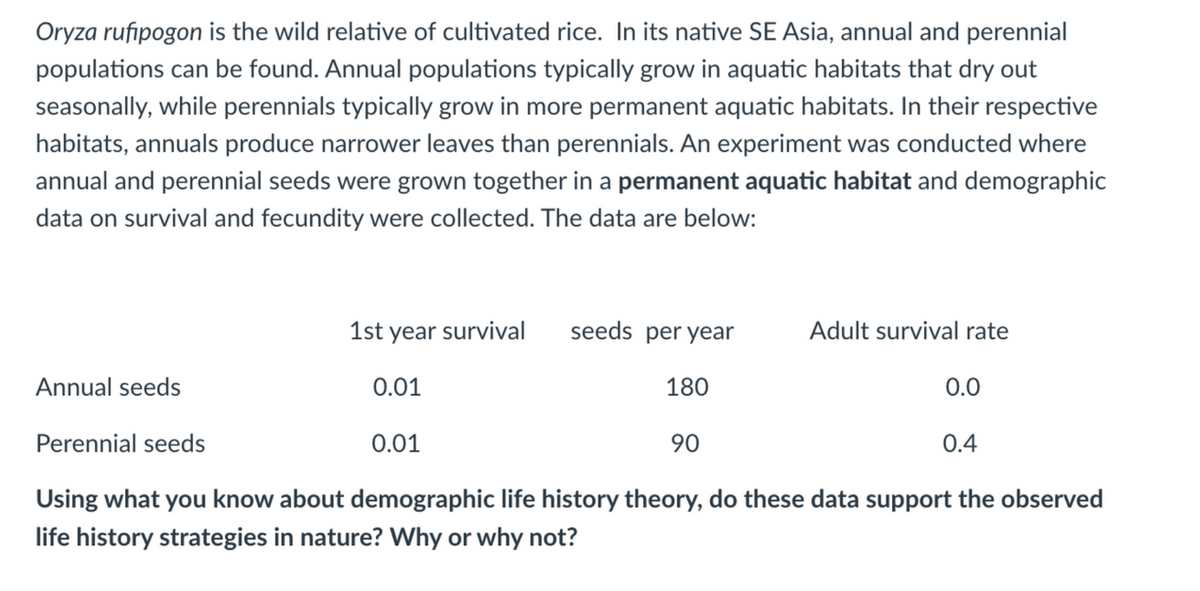Oryza rufipogon is the wild relative of cultivated rice. In its native SE Asia, annual and perennial populations can be found. Annual populations typically grow in aquatic habitats that dry out seasonally, while perennials typically grow in more permanent aquatic habitats. In their respective habitats, annuals produce narrower leaves than perennials. An experiment was conducted where annual and perennial seeds were grown together in a permanent aquatic habitat and demographic data on survival and fecundity were collected. The data are below: Annual seeds 1st year survival 0.01 0.01 seeds per year 180 90 Adult survival rate 0.0 Perennial seeds 0.4 Using what you know about demographic life history theory, do these data support the observed life history strategies in nature? Why or why not?
Oryza rufipogon is the wild relative of cultivated rice. In its native SE Asia, annual and perennial populations can be found. Annual populations typically grow in aquatic habitats that dry out seasonally, while perennials typically grow in more permanent aquatic habitats. In their respective habitats, annuals produce narrower leaves than perennials. An experiment was conducted where annual and perennial seeds were grown together in a permanent aquatic habitat and demographic data on survival and fecundity were collected. The data are below: Annual seeds 1st year survival 0.01 0.01 seeds per year 180 90 Adult survival rate 0.0 Perennial seeds 0.4 Using what you know about demographic life history theory, do these data support the observed life history strategies in nature? Why or why not?
Biology: The Dynamic Science (MindTap Course List)
4th Edition
ISBN:9781305389892
Author:Peter J. Russell, Paul E. Hertz, Beverly McMillan
Publisher:Peter J. Russell, Paul E. Hertz, Beverly McMillan
Chapter53: Population Interactions And Community Ecology
Section: Chapter Questions
Problem 1ITD
Related questions
Concept explainers
Population Growth
R and K Selection
R and K selection are concepts in ecology used to describe traits in the fluctuation of a population or population dynamics. For example, they describe the life-association traits between parent and offspring, such as quantity or number of young ones born at a time, quality of parental care, the age to maturity, and reproductive effort.
Question

Transcribed Image Text:Oryza rufipogon is the wild relative of cultivated rice. In its native SE Asia, annual and perennial
populations can be found. Annual populations typically grow in aquatic habitats that dry out
seasonally, while perennials typically grow in more permanent aquatic habitats. In their respective
habitats, annuals produce narrower leaves than perennials. An experiment was conducted where
annual and perennial seeds were grown together in a permanent aquatic habitat and demographic
data on survival and fecundity were collected. The data are below:
1st year survival
0.01
seeds per year
180
Annual seeds
Perennial seeds
Using what you know about demographic life history theory, do these data support the observed
life history strategies in nature? Why or why not?
0.01
Adult survival rate
90
0.0
0.4
Expert Solution
This question has been solved!
Explore an expertly crafted, step-by-step solution for a thorough understanding of key concepts.
Step by step
Solved in 2 steps

Knowledge Booster
Learn more about
Need a deep-dive on the concept behind this application? Look no further. Learn more about this topic, biology and related others by exploring similar questions and additional content below.Recommended textbooks for you

Biology: The Dynamic Science (MindTap Course List)
Biology
ISBN:
9781305389892
Author:
Peter J. Russell, Paul E. Hertz, Beverly McMillan
Publisher:
Cengage Learning

Biology: The Dynamic Science (MindTap Course List)
Biology
ISBN:
9781305389892
Author:
Peter J. Russell, Paul E. Hertz, Beverly McMillan
Publisher:
Cengage Learning